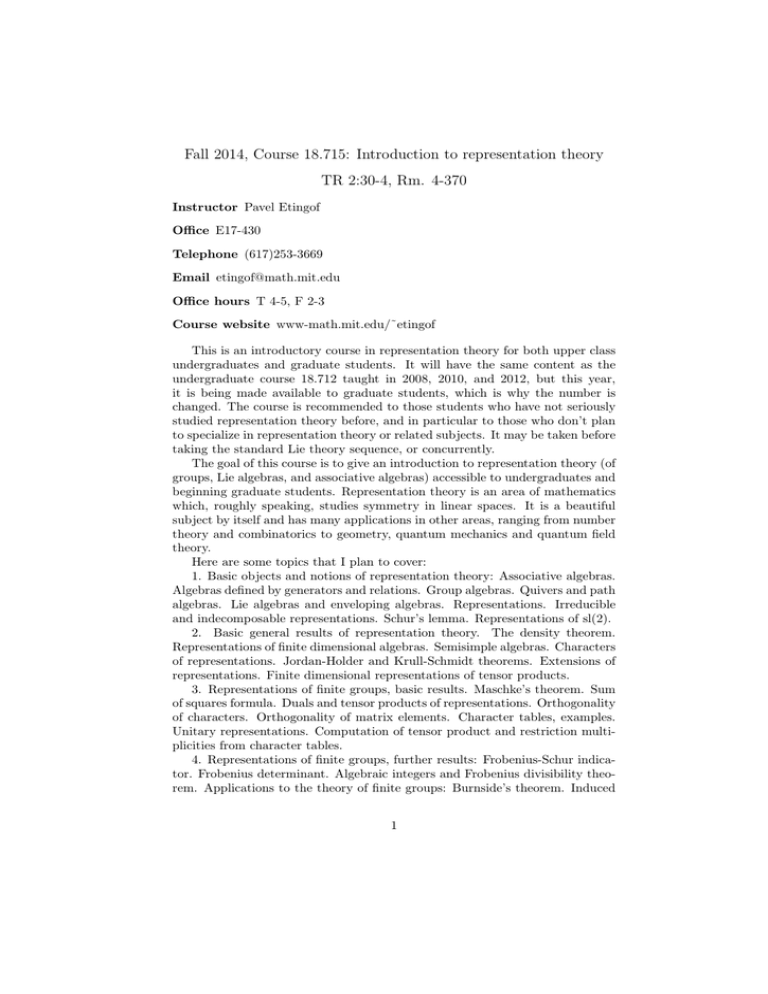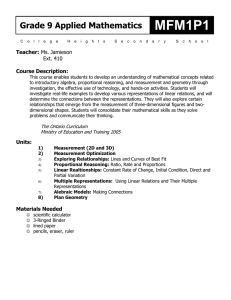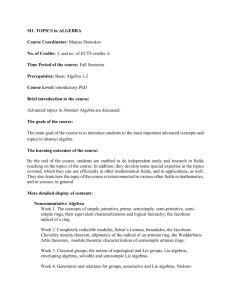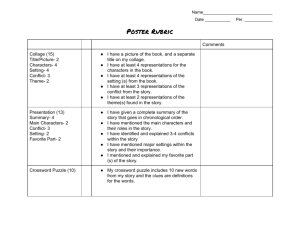Fall 2014, Course 18.715: Introduction to representation theory
advertisement

Fall 2014, Course 18.715: Introduction to representation theory TR 2:30-4, Rm. 4-370 Instructor Pavel Etingof Office E17-430 Telephone (617)253-3669 Email etingof@math.mit.edu Office hours T 4-5, F 2-3 Course website www-math.mit.edu/˜etingof This is an introductory course in representation theory for both upper class undergraduates and graduate students. It will have the same content as the undergraduate course 18.712 taught in 2008, 2010, and 2012, but this year, it is being made available to graduate students, which is why the number is changed. The course is recommended to those students who have not seriously studied representation theory before, and in particular to those who don’t plan to specialize in representation theory or related subjects. It may be taken before taking the standard Lie theory sequence, or concurrently. The goal of this course is to give an introduction to representation theory (of groups, Lie algebras, and associative algebras) accessible to undergraduates and beginning graduate students. Representation theory is an area of mathematics which, roughly speaking, studies symmetry in linear spaces. It is a beautiful subject by itself and has many applications in other areas, ranging from number theory and combinatorics to geometry, quantum mechanics and quantum field theory. Here are some topics that I plan to cover: 1. Basic objects and notions of representation theory: Associative algebras. Algebras defined by generators and relations. Group algebras. Quivers and path algebras. Lie algebras and enveloping algebras. Representations. Irreducible and indecomposable representations. Schur’s lemma. Representations of sl(2). 2. Basic general results of representation theory. The density theorem. Representations of finite dimensional algebras. Semisimple algebras. Characters of representations. Jordan-Holder and Krull-Schmidt theorems. Extensions of representations. Finite dimensional representations of tensor products. 3. Representations of finite groups, basic results. Maschke’s theorem. Sum of squares formula. Duals and tensor products of representations. Orthogonality of characters. Orthogonality of matrix elements. Character tables, examples. Unitary representations. Computation of tensor product and restriction multiplicities from character tables. 4. Representations of finite groups, further results: Frobenius-Schur indicator. Frobenius determinant. Algebraic integers and Frobenius divisibility theorem. Applications to the theory of finite groups: Burnside’s theorem. Induced 1 representations and their characters (Mackey formula). Frobenius reciprocity. Representations of the symmetric group. Representations of the general linear group GL(n, C) and of its Lie algebra. Weyl duality. The fundamental theorem of invariant theory. Representations of GL(2, Fq ). Artin’s theorem. Representations of semindirect products. 5. Representations of quivers. Indecomposable representations of quivers of type A1,A2,A3,D4. The triple of subspaces problem. Gabriel’s theorem. Proof of Gabriel’s theorem: Simply laced root systems, reflection functors. 6. Basics of category theory (categories, functors, natural transformations), examples. Representable functors, Yoneda lemma. Adjoint functors. Abelina categories. Right exact, left exact, and exact functors. 7. Projective modules. Lifting of idempotents. Classification of indecomposable projective modules over a finite dimensional algebra. The prerequisites for the course are the standard algebra sequences 18.701/702 or 18.700/703. This means that to understand this course, it is necessary and sufficient to have a strong background in linear algebra and a decent understanding of basic algebraic structures, such as groups, rings, and fields. We will prove some general results, but a lot of the attention will be paid to examples, and there will be many hands-on exercises illustrating the course. You can get a good idea of what this course is going to be like by looking at these notes: www-math.mit.edu/˜etingof/replect.pdf The textbook for the course will be “Introduction to Representation Theory” by Pavel Etingof, Oleg Golberg, Sebastian Hensel, Tiankai Liu, Alex Schwendner, Dmitry Vaintrob, Elena Yudovina, with historical interludes by Slava Gerovitch, AMS, 2011, which is an expanded version of the notes. Besides, you may also use the beginning part of the book by W. Fulton and J. Harris “Representation theory: a first course”, and the book by J.-P. Serre “Linear representations of finite groups”. To pass the course, it will be required to solve homework assignments which will be assigned every Thursday and due the following Thursday. The homeworks are 75% of the grade. It is ok to collaborate on homework if you creatively participate in solving it and understand what you write. Also there will be a takehome final assignment at the end of the term, which will weigh 25% of the grade. 2








